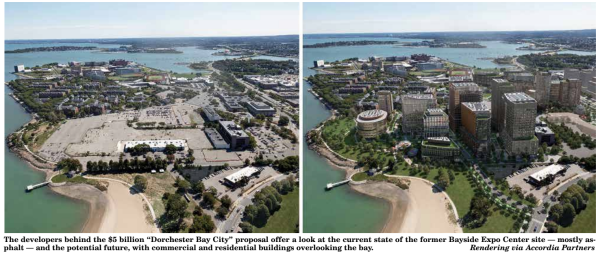January 25, 2023

The latest iteration of “Dorchester Bay City” earned plaudits from community members as the $5 billion proposal, which would remake the former Bayside Expo Center and the Santander Bank complex on Morrissey Boulevard into a sprawling mixed-use development, continues to move through the public review process overseen by the Boston Planning and Development Agency (BPDA).
When the project’s two top developers, Kirk Sykes and Dick Galvin of Accordia Partners, met virtually with members of the Morrissey area’s community advisory committee last Wednesday (Jan. 18), Sykes said the development comes with $365 million in public benefits and $100 million in transportation fixes, which are desperately needed in the surrounding area, which includes Kosciuszko Circle and Morrissey Boulevard.
City and state officials are working to overhaul the two well-traveled roadways amid various other development proposals that would bring thousands of residents and office workers to the area.
Galvin said they remain hopeful that “Dorchester Bay City,” which is expected to take decades to complete, will help catalyze and keep on track fixes to Morrissey, K Circle, and Mt. Vernon Street. “I think we’re on a good path to realizing that vision,” he said.
Kathy Abbott, one of the members of the Morrissey community advisory committee, said she was pleased to see improvements to the original proposal. The latest version of Dot Bay City calls for the removal of a building from an earlier plan and the addition of a 6,300-square-foot pavilion, as well as a 2.7-acre town green. An esplanade has been added to the 36-acre project, and two buildings have been moved back toward Mt. Vernon Street, increasing the setback from the shoreline.
Overall, the size of the development has been reduced to 6.1 million square feet from 6.5 million, and green space has increased to 9 acres, from 6.8 acres. The project is expected to generate 25,000 construction jobs and 15,000 permanent ones.
Nearly 2,000 housing units would be created, with affordable housing making up 20 percent of that, up from the 13 percent requirement. The project will also funnel $53 million into the city’s Neighborhood Housing Trust and contribute $10 million to a Massachusetts Affordable Housing Alliance (MAHA) fund for first-time homebuyers.
The latest plans will be the focus of several upcoming BPDA-meetings. A session on the housing aspect of the project is set for Wed., Feb. 1, at 6 p.m., and transportation will be the topic at a 6 p.m. meeting on Feb. 13. A meeting on climate resiliency occurred this week.
Don Walsh, who was a key figure in the Columbia Point master planning process more than a decade ago, said he liked the project. “Hurry up, I’d like to see it done so I can enjoy,” he quipped to the developers.
Sykes and Galvin are aiming for BPDA approval by this summer, with Galvin saying they’d like to start “moving dirt” on the site by the middle of 2024. “Let’s put the economy aside for the moment,” he said in outlining the timeline, a reference to rising interest rates and darkening economic clouds on the horizon.
Rising sea levels present another issue for the project. Raising the project site — elevating it to 21.5 feet — to protect against sea level rise is expected to cost $166 million. The developers aim to add 1,000 trees, which will help cool the area, currently covered in asphalt, by 30 degrees in a reduction of the “heat island” effect.
The project will also lead to $36.8 million in off-site transportation improvements, in addition to $62 million for a street network within Dorchester Bay City’s borders.
“It seems like it would feel good being a pedestrian there,” said Taufiq Dhanani, a member of the community advisory group.
The project would also bring benefits to UMass, which is leasing the former Bayside Expo property to the developers for $200 million. Additionally, the state would take in $43 million in new tax revenue, and City Hall would receive $80 million in annual property taxes.
Galvin said there are no plans to have UMass undergraduate housing at Bay City. UMass Boston has built dorms on the commuter campus, and the first 1,000-bed residence hall opened in 2018, 44 years after the public university moved to Columbia Point.
Ahead of the community advisory group’s meeting, Marcelo Suárez-Orozco, UMass Boston’s chancellor, sent out a note of support for the project, which he called “critical” to the campus and Columbia Point.
“The partnerships and investments from this privately funded project provide unique opportunities for UMass Boston to enhance the student experience, improve academic programs, expand internship opportunities, provide capital improvements, and strengthen engagement with local communities,” he wrote.
“The development aims to bring housing, significant R&D space, retail and commercial activity, as well as open space amenities that will be accessible to our UMass Boston students, faculty, staff, and the community at-large,” he noted. “It will also serve as a stunning gateway to the UMass Boston campus.”


